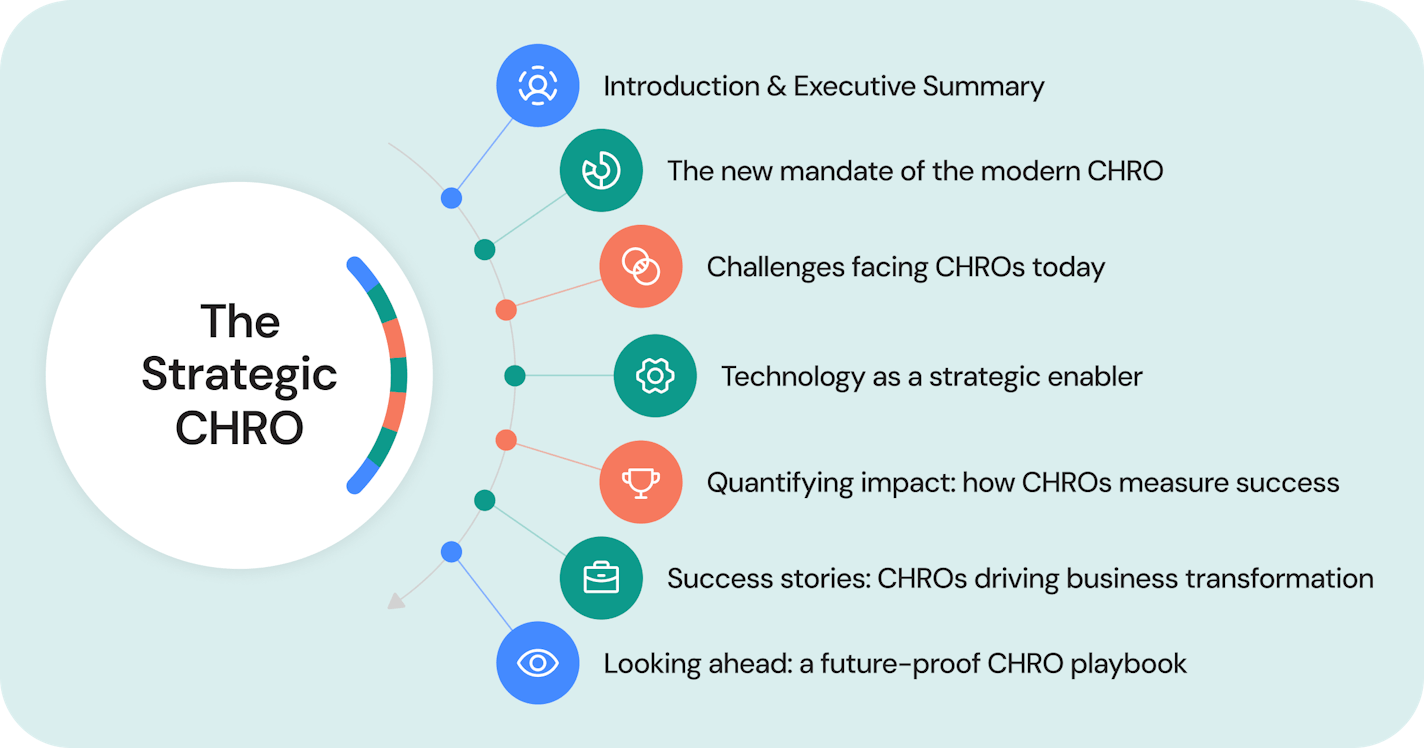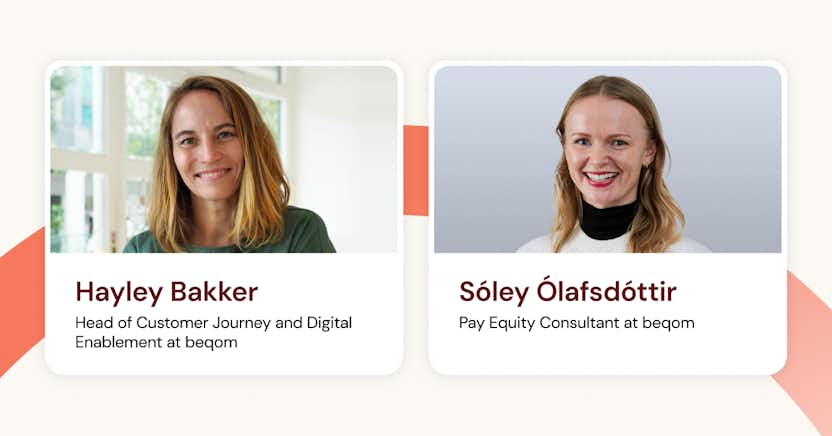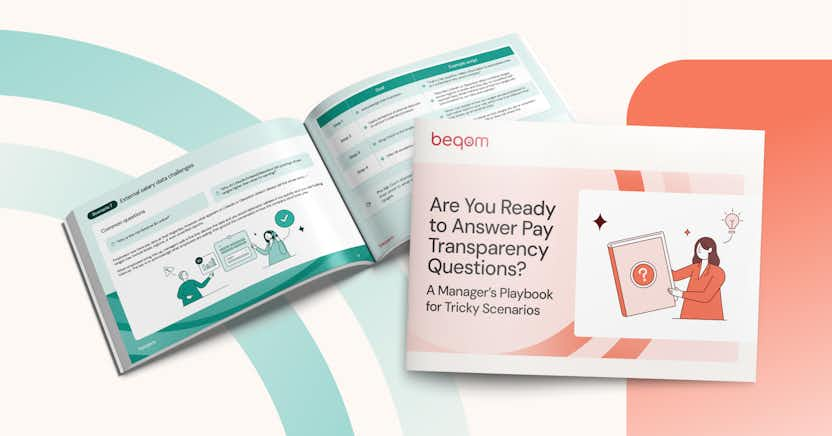The Strategic CHRO: A Playbook for Transformation

The CHRO role has evolved into one of the most strategic positions in today’s enterprise. As organizations face rapid AI disruption, workforce transformation, and rising expectations for transparency and purpose, the CHRO is at the forefront—guiding change from within. This role is about shaping the future of work, driving business performance, and aligning people strategy with long-term organizational goals.
So what does this transformation look like in action? It begins with a holistic approach — one that integrates performance, culture, and technology to unlock the full potential of the workforce.
That’s why we created The CHRO’s Guide to Strategic Leadership — a practical playbook designed to help HR leaders connect talent, culture, and innovation to fuel enterprise growth. It covers:

Download it below or continue reading for a quick summary of its key points!

Get your free copy of The CHRO’s Guide to Strategic Leadership for an in-depth guide to become a strategic force in shaping your company’s future.
What does it mean to be a strategic CHRO?
A strategic CHRO goes beyond operations and compliance. They are:
- A business partner who connects workforce strategy to business outcomes.
- A change leader navigating disruption and complexity.
- A culture architect shaping the employee experience.
- A tech-savvy decision-maker who leverages data and AI.
This role shift is already happening across industries, and it’s redefining the expectations placed on HR leaders.
Why is now the time to act?
Three major forces are converging to make this a defining moment for CHROs:
- The rise of AI and automation
Technology is transforming how work is done. CHROs must lead reskilling efforts, redefine roles, and integrate AI responsibly. - Workforce expectations have changed
Flexibility, purpose, and transparency are non-negotiable for top talent. HR leaders must evolve the employee experience to stay competitive. - Regulatory complexity is growing
Pay equity, privacy, and transparency laws are tightening. Strategic CHROs must ensure compliance while reinforcing brand integrity.
Taken together, these trends create an opportunity for CHROs to lead from the front.
What are the key components of a strategic HR playbook?
A truly strategic HR playbook helps CHROs turn vision into execution. It includes:
1️⃣ A clear mandate tied to business goals
CHROs need to be involved in shaping strategy — not just implementing it. They must align talent priorities to growth objectives, M&A plans, or new market expansion.
2️⃣ Talent strategies for today and tomorrow
CHROS should focus on workforce planning, upskilling, succession, and internal mobility, and use AI-driven insights to anticipate future skill needs.
3️⃣ A tech ecosystem that drives results
CHROs will benefit from adopting platforms that go beyond process automation — like compensation systems that ensure fairness, or performance tools that support continuous feedback.
4️⃣ Metrics that link HR to impact
Top CHROs use dashboards to track engagement, retention, and equity — and tie those metrics to financial outcomes like revenue per employee or innovation velocity.
5️⃣ An inclusive and agile culture
CHROs should build leadership programs, feedback loops, and structures that support fast change without losing cultural coherence.
What are common questions CHROs are asking?
As the role of the CHRO evolves, so do the questions HR leaders are asking themselves — and their organizations. These are strategic questions that reflect the expanding influence and responsibility of HR and the role of the CHRO. Below are some of the most pressing topics on CHROs’ minds, along with answers to help guide next steps.
What should CHROs focus on in 2025?
As organizations adapt to rapid technological, cultural, and economic shifts, CHROs are expected to prioritize initiatives that directly impact business resilience and workforce readiness. These focus areas reflect both industry research and trends observed among leading global CHROs:
- Building skills for AI and digital transformation.
- Ensuring pay equity and transparency readiness.
- Designing a flexible, personalized employee experience.
- Driving leadership accountability for culture and performance.
What does success look like for a CHRO today?
Success means more than just hitting some HR KPIs — it is reflected by how well the workforce enables innovation, growth, and adaptability. A successful CHRO aligns people strategy directly with business priorities — ensuring the right talent is in place, equipped with the right skills, and supported by a culture that encourages agility and performance.
Success can be seen when the organization adapts quickly to change, retains high performers, launches initiatives faster, and maintains strong employee engagement and trust. To track this, CHROs should partner with business leaders to link workforce metrics (like internal mobility, time to productivity, or engagement scores) to broader outcomes such as revenue growth, customer satisfaction, or innovation cycles.
What tools are essential in the CHRO tech stack?
To lead effectively and deliver measurable impact, CHROs need more than just a centralized HRIS. A modern HR tech stack should include specialized tools that support strategic capabilities — from equitable compensation to performance alignment and real-time engagement insights. These systems enable CHROs to make data-driven decisions, streamline processes, and scale best practices across the organization:
- Compensation management
- Performance and goal alignment
- Engagement and feedback tools
- Pay equity and transparency tools
- AI-powered talent insights
How does AI help CHROs lead better?
AI enables smarter decisions in hiring, compensation, and engagement by uncovering patterns, reducing bias, and personalizing the employee journey.
CHROs can start by identifying high-impact use cases — such as using AI-powered tools to screen candidates more fairly, analyze compensation for pay equity gaps, or assess engagement sentiment across teams. Begin with a pilot in one area, measure outcomes, and build internal understanding and trust before scaling AI adoption more broadly.
Real-world examples of CHRO-led transformation
The most effective CHROs are already demonstrating the power of this playbook.
- At Mercedes-Benz, Sabine Kohleisen led a €1.3B workforce reskilling program to support the company’s electric future.
- At Cisco, Francine Katsoudas redefined flexibility and well-being as pillars of performance.
- At a leading global bank, the CHRO implemented beqom’s unified compensation and performance platform to drive alignment, transparency, and retention.
Each case shows that when HR leads, business outcomes follow.
How can CHROs start building their own playbook?
Start by identifying your top three challenges — whether it's retention, skills gaps, or compliance — and build strategies around them. Engage with your CFO and COO to align workforce initiatives to enterprise goals. Invest in tech where it creates measurable impact. And don’t go it alone — partner with solution providers who understand the CHRO’s strategic role.
Download the CHRO's Guide to Strategic Leadership to see how technology and strategy can come together to lead business transformation.
How best-of-breed HR systems drive business outcomes
Today’s most effective CHROs are choosing best-of-breed solutions that go beyond automation to deliver real business value. Rather than relying on generic HR suites, they’re adopting specialized platforms that offer depth in critical areas like compensation, performance, and pay equity. These tools provide the precision, flexibility, and insight needed to align people strategy with business objectives — enabling faster decision-making, greater transparency, and measurable impact.
beqom is one such solution. Our best-of-breed platform helps CHROs manage compensation, performance, and pay equity on a global scale, empowering HR teams to build fairness, accountability, and alignment into the fabric of the organization.
Ready to talk to an expert about your HR challenges? Send us a message or book a demo.







